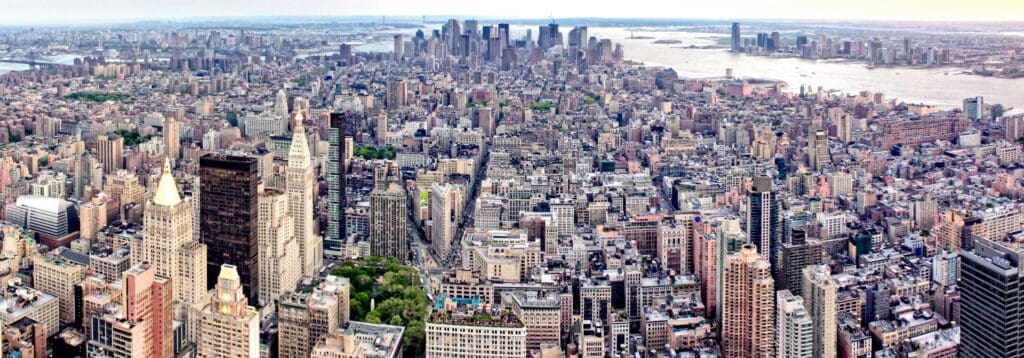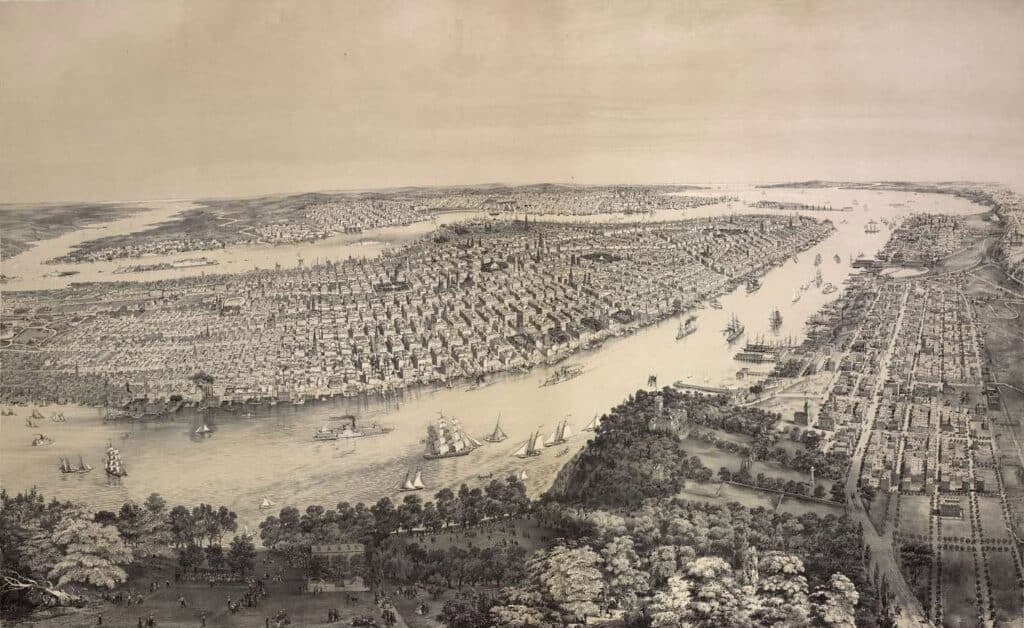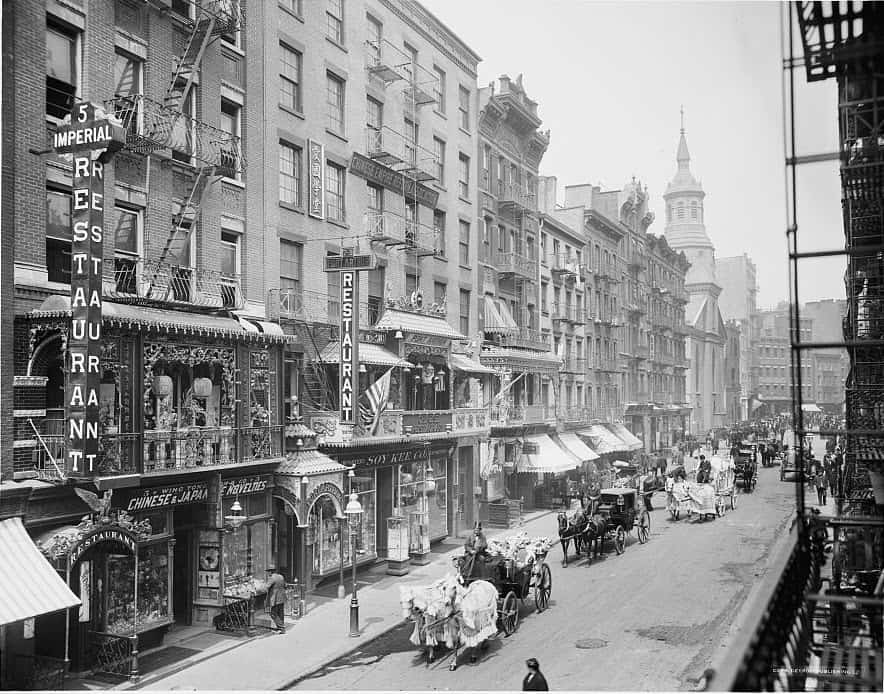History of New York City

Welcome to Sea the City, where our blog explores all things New York City, from its history and culture to its people and landmarks. So, if you’ve ever wondered, “What is the history behind New York City? You’ve come to the right place.
Today, let’s take a dive into just how big the Big Apple really is and when it was founded.
How Big Is New York City?
New York City comprises five boroughs, Manhattan, Brooklyn, Queens, Staten Island, and The Bronx, that sit where the Hudson River branches into the Atlantic Ocean. The population of New York City as of 2023 is 7,888,121 million, according to World Population Review. The population is spread over 302.64 square miles. That’s a lot of people packed into quite a small space! It’s no surprise that New York City is the most densely populated city in the United States and one of the densest cities in the world.
When Was New York City Founded?
New York City was founded in 1624 by Dutch colonists and was one of the original 13 colonies. Old New York was originally called New Amsterdam. In 1664, the English seized control of New Amsterdam from the Dutch and changed its name to New York after the Duke of York, who later became King James II of England.
Who Founded New York?
The original founder of New York City is widely accepted to be the Dutch explorer and merchant Peter Minuit. He was appointed the first Director-General of the colony by the Dutch West India Company and was responsible for facilitating the purchase of Manhattan Island from local Native Americans.
New York City Historical Timeline

So, how old is New York City? Today, it’s nearly 400 years old. Let’s take a look at some of the key moments in New York City’s history over the centuries.
New York Pre-1500s
The Lenape Native Americans initially inhabited New York City. It is believed that they first settled in what would later become New York around 10,000 BCE. One trace of the Lenape in modern NYC is Broadway, which was originally known as Wickquasgeck Trail. It was used by the Lenape to travel between settlements.
New York 1500s
When was New York discovered? That would be in 1524, Italian explorer Giovanni da Verrazzano became the first European to explore New York Harbor. He was working for the French king, Francis I, and was looking for a new sea route to Asia. However, he did not find the route he sought and sailed away without establishing any settlements.
In his reports to the king, Verrazzano described the North American coast. There is a bridge named after him at the entrance to the New York Harbor – the Verrazzano-Narrows Bridge. It unites the boroughs of Brooklyn and Staten Island.
New York 1600s

In 1609, Henry Hudson was hired by the Dutch East India Company to explore the area that would become New Amsterdam. In 1621, European fur hunters and traders settled in the area.
If you’ve ever wondered who established New York City, it was the Dutch in 1623. That year, the Dutch West India Company established a trading post in New Amsterdam, the first permanent European settlement in New York City. In 1624, Peter Minuit was appointed as Director-General of New Amsterdam and facilitated the purchase of Manhattan Island from local Native Americans. The price paid was 60 guilders’ worth of goods, which is equivalent to about $1,000 today.
In 1664, the English seized control of New Amsterdam from the Dutch and changed its name to New York. Over the next few decades, the Dutch established trading posts and settlements throughout the region, including what is now Brooklyn and Queens.
The English established a colonial government and expanded the colony by encouraging immigration and settlement. By the mid-1700s, New York City had become a major commercial center and was home to a diverse population of European, African, and Native American people.
New York 1700s
What was NYC like in the 1700s? For starters, it was a time of establishing its independence from Great Britain. The Declaration of Independence was adopted on July 4, 1776, igniting the Revolutionary War with Great Britain. Later, the American Revolutionary War was won on September 3, 1783.
In 1790, New York City became the first capital of the United States and remained so until 1797, when Philadelphia was chosen as the new capital. During this period, New York was a major trading center for goods such as cotton, tobacco, wine and spirits. In 1792, the Stock Exchange opened in New York City and the Manhattan banking system was established.
New York 1800s

History museums abound in the City that Never Sleeps. Back in 1804, the first NYC museum was founded: The New York Historical Society Museum.
In 1811, the streets of New York City were laid out in a grid plan that still exists today. In 1817, New York City construction began on the Erie Canal, which connected the Hudson River to Lake Erie and allowed goods to be transported more easily between the east coast and Midwest. By the mid-1800s, New York had become the nation’s busiest port.
In 1825, the Erie Canal was completed, and it transformed New York City into a major commercial center and established trade with other parts of America and Europe. In 1839, the first horse-drawn streetcars began operating in New York City.
At the start of 1865, the New York City Industrial Revolution began and ran until early the early 1900s. During that time, the city experienced tremendous growth in factories and industry.
This period was also marked by rampant immigration as people from all over Europe came to New York City seeking a better life. Ellis Island, the gateway to America for millions of these immigrants, opened in 1892.
The Statue of Liberty, a gift from France, arrived in New York City in 1885 and was dedicated the following year. The gift became an icon of freedom and hope for people worldwide. Ellis Island, the gateway to America for millions of immigrants, opened in 1892.
20th-Century New York
By the 20th century, New York City was an important cultural center and a center of finance and trade. The city was home to some of the world’s most famous skyscrapers, such as the Empire State Building (1931) and the Chrysler Building (1930).
In 1904, the subway opened in New York City, and it remains one of the world’s busiest public transportation systems. The United Nations Headquarters was established in New York City in 1952.
How New York City Got Its Nicknames
New York City has been known by many nicknames over the years, including the “Big Apple”, “Gotham,” and “the City That Never Sleeps.”
Here are the stories behind the names:
- The Big Apple was first popularized in the 1920s by New York Morning Telegraph sportswriter John J. Fitz Gerald. New York tourist authorities have kept the nickname alive by using it in marketing campaigns.
- Gotham, derived from Old English words for “goat” and “town,” first appeared in famous American author Washington Irving’s satirical magazine Salmagundi (1807). Irving’s stories depicted New York City as a place populated by foolish people.
- The City That Never Sleeps is probably the most prominent of New York City’s nicknames. It was first used in the 1900s. It refers to the continuing hustle and bustle of the city and the fact that the subway system never shuts down. The moniker was cemented in history after Italian-American crooner Frank Sinatra popularized it in his song, “(Theme From) New York, New York.”
As you can see, New York City is one of the most famous cities in the world, with a long, rich history. From its founding in the 1600s by Dutch settlers to becoming an important cultural, financial, and commercial center in the 20th century, New York City has played an important role in American and world history.
Today, New York City is one of the world’s most populous cities and a major tourist destination. It continues to be an important cultural, financial, and commercial center.
Discover Even More About NYC with Sea the City
Now that you know a bit more about New York City’s history come explore Sea the City and discover even more! At Sea the City, you can experience all the best attractions of this iconic city while learning about its past through jet ski rides or hot tub boat tours.
Join us today and start exploring the five boroughs of The Big Apple! You can book your tour here!
